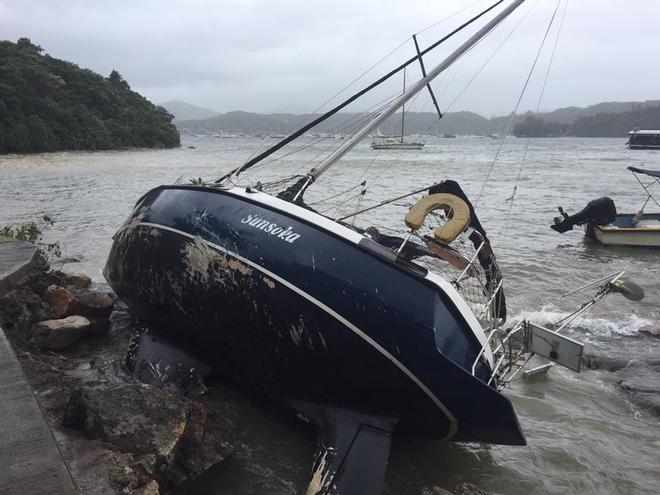Typhoon Hato - a cautionary reminder to ALL boat owners
by Colin Ip on 24 Aug 2017

Pak Sha Wan, the aftermath of Typhoon Hato Steve Pheby
[Ed: We have seen some desperately sad images from the last 24 hrs, from a myriad of catamarans trashed at Hobie Beach, Tai Tam, to boats adrift in Hebe Haven (Pak Sha Wan). There are going to be a few insurance claims filed in the near future, but not everyone is going to be happy with the result.
Back in 1999, Typhoon York achieved T10 staus when it blew through Hong Kong. My good friend Colin Ip remembers, reminds, and advises… ]
“The most indelible image of that day was seen from the roof top of our flat in Che Keng Tuk - the sad sight of seeing a number of yachts being dragged across the cove and ending up on rocks, or, seeing their running rigging, sails, covers etc. being flogged and flayed apart.
I was a marine surveyor and loss adjuster at the time, and so spent a good few months going around the marinas, anchorages and boat clubs, surveying and assessing the carnage post-York. Being a yachtie, it was a sad and moving sight to see hefty yachts that had ended up in the mangroves or on the rocks, hundreds of metres away from what was normal high high tide line. Hobies at Tai Tam Bay and Darts at Discovery Bay tossed around and in pieces.
Harder still was explaining to distraught owners why their claim for damages would not be paid by the insurance companies – ‘Fully Comprehensive’ does not mean a payout for all and any eventuality. If that was the case, then your policy would simply be a one pager: effectively, a guarantee from the insurance company.
So it's pretty alarming to see the same consequences happening again post-Hato. Hobies with covers and trampolines still attached, yachts with bimini covers, sail covers, sails still attached, and yachts with kayaks and removable fittings (BBQs, life rings) still lashed or otherwise attached to the rails.
For those owners, you are not going to be happy bunnies.
Marine insurance policies in Hong Kong are very clear: on the hoisting of a T3, these items have to be removed from the boat. A typhoon is a foreseeable event, and therefore the insurance company expects a degree of prudence from the owner insured to minimise damage as much as possible.
Leaving covers, sails and loose items still attached to your yacht when a typhoon is coming is not prudent! Nor is it the Club's (whether RHKYC, HHYC, ABC, etc) responsibility to look after your boat and remove these items for you. Your boat. You are the insured. Your responsibility!
If in doubt, speak to your insurance broker or a yacht broker, speak to your marina manager, speak to experienced owners, and read club notices about what to do in the event of an oncoming typhoon. The acid test is this: what would you do to prepare your boat for an incoming typhoon if you had no insurance?
And it is not just about your boat - think about other owners and their boats moored next to yours. If your inaction in a typhoon results in third party consequential damage to somebody else yacht, and your insurance voids your claim... you are going to have to pay up for third party damage, too!'
If you want to link to this article then please use this URL: www.sail-world.com/156657